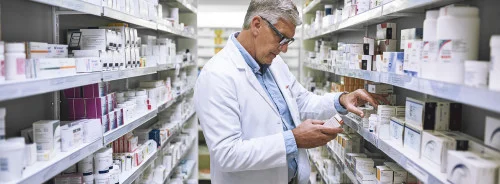HealthManagement, Volume 9, Issue 1 /2007
Authors:
Prof. Wilfried von Eiff and Nora Meyer
Institut für BWL (Hospital management)
Münster, Germany
E-mail: [email protected] ou
Ingo Leufke Münster, Germany
E-mail: [email protected]
The
current reforms in the German healthcare system seem to focus on maintaining
the quality of care in hospitals while cutting the high costs and reducing duration
of stay. The laboratory-diagnostic management process can contribute
substantially to achieving these objectives. The importance of laboratory
diagnostics in terms of DRGs can be illustrated on the basis of the following
figures.
Two out of three times, the doctor’s diagnosis is based on laboratory results. Due to the confirmation of 62% of secondarydiagnosis – primarily because of laboratoryparameters – the laboratory becomes even more importantfor coding and hospital reimbursement. Moreover,the hospital laboratory is responsible for up to 70% of allservices rendered to patients, yet constitutes only three tofour percent of the hospital’s total budget. Consequently,the clinical laboratory becomes a valuable, indispensableand competent partner to the hospital. In future it wouldno longer be a pure cost centre but rather a substantialcontribution to the hospital’s profitability. The managementof clinical laboratories are faced with multipleoptions when it comes to applying the requirements ofthe DRG system fairly.
Figure 2 illustrates new communication channels, changes to the organisation, possibilities regarding new EDP, cooperation possibilities and outsourcing laboratory functions as options to optimise the management of a laboratory.
The introduction of the DRG system demands efficient processes and operational sequences in the hospital make sure that the most cost effective services are delivered as these will only be reimbursed by a flat-rate amount.
In future, laboratory parameters should no longer be requested in an unfocused and random manner. There will be more differentiated, question-oriented research samples, which could possibly be controlled by real time coding.
The range of tasks carried out by the laboratory will develop from merely providing requested results into an independent function within the clinical pathway. Many clinical pathways should also incorporate the laboratory diagnostics.
Not only because 62% of compensation relevant secondary diagnosis is mainly confirmed by laboratory results and can thus be documented as being “MDKapproved” (medical fund) but also because the requirements of laboratory results are easy to standardise and could be simplified by electronic data processing assistance.
The laboratory of the future will be measured in terms of its delivery speed and then its cost e f f e c t i v e n e s s . Rapid feedback from laboratories makes shorter patient pathways possible. Around he clock availability is therefore the most important requirement of a laboratory in a DRG system. The consequences of unsuitable antibiotic treatment lead, for instance, to longer waiting times, further and more intensive diagnosis, more extensive and thus more expensive therapy or even longterm consequences. In critical cases, i.e. clarification of the MRSA status, immune status, etc., the laboratory is an indispensable diagnostic partner of the treating physician. Moreover, the requirements of the DRG system must be met by means of electronic data processing (EDP).
An extensive paperless laboratory information system - from entering a request to receiving the results at the station – should be standardised. The test results of the laboratory become available to the stations (on their monitors) immediately after the technical and medical validation. In 80% of all cases, data from the laboratory are available in less than an hour. So, a special emergency laboratory becomes superfluous. To ensure the correlation between test results and the DRG coding, more EDP support would be needed.
Basis laboratories in various hospitals, which have a similar structure, can be centralised and run by a central specialist or a hospital laboratory. Analyses needed on a daily basis for diagnostics must be locally available. They cover about 80% of the testing revenue. The remaining 20%, uncommon and infrequent tests, should be centralised and outsourced.
Medical care centres are part of integrated care. Amongst CHI physicians – in certain regions - supra-local laboratory communities already exist.
In terms of inter-disciplinarity, combinations with other diagnostic fields such as pathology, radiology or microbiology would be possible for the clinical laboratory. The economic advantage of the MVZ in comparison to other forms of care lies with the contribution of borrowed capital as well as the possibility to conclude economically interesting compensation agreements, which do not fall under the standard benefit volume.
Generally speaking, outsourcing can have positive effects on a h o s p i t a l . Outsourcing causes neither closure nor a hostile takeover. Cooperation and partnership should be the absolute criterion for both parties because the prospect of bankruptcy will have more negative repercussions for all involved. When considering outsourcing the laboratory function, one should bear certain considerations in mind e.g. 93 out of 100 errors are made outside the clinical laboratory.
The transport of samples to an external “special laboratory” has grown tremendously.
The reason for this development is that large laboratories can carry out high quality tests at reasonable fees due to the high volumes of work they receive. This means that results become available later because the samples have to be taken to an external laboratory first. In the DRG context, long waiting times – hours or even days – is just not acceptable. Empirical experience shows that 80% of the analyses can be done right there. Many types of tests should be available at all times. These issues have to be discussed before considering outsourcing.
If you do decide to outsource, no more than 51% to 74% should be subcontracted to an external partner. The hospital’s remaining capital share would ensure that the partner does not realise any price leads. Additionally, the hospital also shares in the profit if higher revenues are generated. This is the incentive for both parties: the financial aspect. Ensuring increased efficiency and getting new business relate to hospital business. strengthens the hospital’s profitability and ensure job security.
To do this, employees have to agree to competitive work contracts. In the case of a laboratory, only financial, personnel and organisational responsibilities would be transferred to the external laboratory partner, who commits to take on the routine analyses of the hospital, and guarantees around the clock care. This requirement should be particularly emphasized as to facilitate a shorter waiting period within the DRG system.
When negotiating with external laboratories over price, consider the comparability of the cost of in-house services and that of external suppliers. Do not compare the higher hospital prices one-to-one with the cheaper offer of the established laboratory.
Rather, weigh the optimised in-house services up against the all-hours service (such as that of the potential partner) and then compare their prices. It is always advisable to remember that quality supersedes price. Small and medium-sized hospitals are at an advantage. Apart from becoming more effective, they are also obtaining expert diagnosis knowledge. The above-mentioned arguments and options underline the importance of a laboratory in DRG.
The laboratory diagnostics have a large influence on the medical and business objectives of the hospital and should not be seen as a cost factor, but rather as a key process in the value chain with an optimising effect.
The laboratory contributes to cost reduction and improving quality in the patient-value supply chain.





